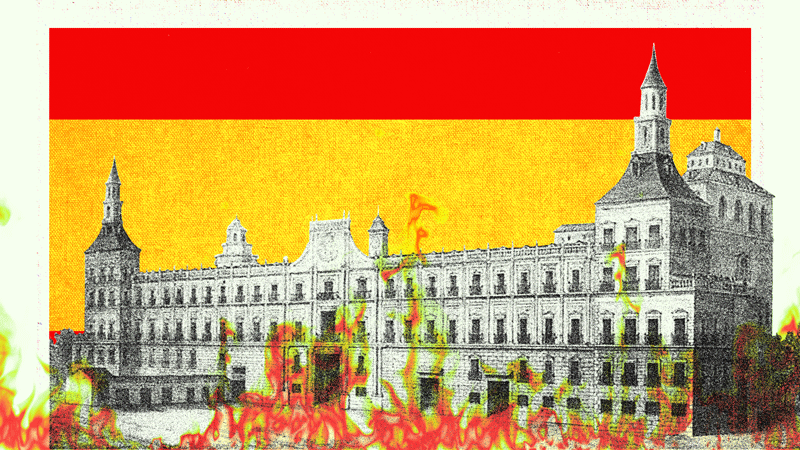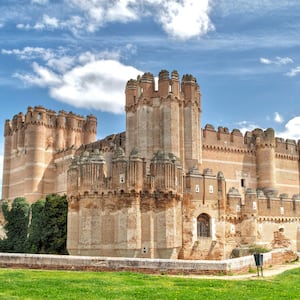It was Christmas Eve in 1734, and most of the residents of the Real Alcázar de Madrid, the palace that housed the Spanish royal court, were in the chapel pews to observe midnight Mass.
As the local priest likely waxed on in Latin about Bethlehem and the wise men and a star that lit up the night sky over a thousand years before, the inhabitants were unaware that a glow of a different sort was beginning to emanate from their very own castle.
On the other side of the palace, a fire had broken out in the rooms of the French painter Jean Ranc, who had been working as the Spanish royal family’s official portraitist.
ADVERTISEMENT
Exact details of the events that followed have been obscured by the smoky haze of time, but whispers of how the disaster unfolded have drifted down through the years.
The story goes that Ranc’s failing eyesight led to a delay in his detecting the flames. When he finally did raise the alarm, the fire bells are thought to have been mistaken for the expected chimes that ushered in the holiday celebrations. Then, of course, there was the fact that the majority of the castle’s occupants were confined to the chapel, unable to quickly attend to the growing inferno.
“For fear of looting, the fortress doors had been ordered shut, which hampered evacuation efforts, though in the end there was little loss of life, with only a handful of palace attendants dying in the blaze,” Jules Stewart writes in Madrid: The History. “But several hundred works of art were consumed by the flames.”
In the end, the Alcázar burned to the ground, taking with it more than 500 works from the Spanish royal family’s art collection.
Built in the mid-ninth century, the Alcázar was witness to nearly a thousand years of Spanish history. It was originally built by Emir Mohamed I, the ruler of what would become Madrid, following the Moors’ conquest of the Iberian peninsula. (“Alcázar” means “castle” in Arabic.)
After the Christians regained control and ultimately installed the Spanish monarchy, each successive ruler put his own touch on the palace he inherited—a little nip-tuck over here, a massive architectural enhancement over there.
It was this propensity for remodeling that provided one of the spots of light on that devastating Christmas Eve. In preparation for a new bout of construction, a large part of the collection that had been amassed in the previous century by the art-loving Habsburgs had been relocated to a different palace shortly before the fire. They were spared from the tragedy as were some of the paintings that hung on the Alcázar’s walls.
After the frantic mayhem following the initial fire alarm, a heroic effort was made to save some of the art while the blaze raged on.
Many of the paintings were securely hung high on the walls, and it was ultimately determined that the best way to rescue them was to cut them out of their frames and chuck them out the window to safety in the courtyard below. In this way, around 1,200 works are believed to have been saved, including masterpieces like Diego Velázquez’s “Las Meninas” and Titian’s “Equestrian Portrait of Charles V.”
“Each artwork saved from the 1734 Alcázar fire is a small miracle,” Noah Charney writes in The Museum of Lost Art. “One can imagine the servants, monks and palace officials rushing through the blazing building, trying to save all they could: hurling works from the windows, choking on smoke, trying to decide what could be saved and what could not.”
Among the 500 works that were lost in the fire are some that disappeared without any trace that they ever existed; others left behind records of the masterpieces that once graced the Alcázar’s walls and the knowledge of the cultural loss that ensued.
Among these were several Titian paintings including every one of the 11 “Caesars” in his Roman Emperors series and two paintings, “Tantalus and Ixion,” from his mythological series. Rubens’ “Equestrian Portrait of Philip IV,” Veronese’s “Moses in the Nile,” and Tintoretto’s “Pyramus and Thisbe” were among those that disappeared, as were unknown paintings by Leonardo da Vinci, Bosch, Raphael, and El Greco.
Perhaps the artistic oeuvre that took the heaviest hit was that of the great 17th century Spanish artist Velázquez, whom art historian Everett Fahy described as “the most admired—perhaps the greatest—European painter who ever lived.”
While “Las Meninas” was saved, many other canvases by the artist were destroyed including his well-known masterpiece “The Expulsion of the Mariscos” and one of his rare female nudes, “Venus and Adonis.”
Born in 1599, Velázquez was painting during a time when it was difficult to pursue the favored classical subject of the scandalously clad lady. Four decades prior to his birth, the Catholic Church had convened the Council of Trent and passed an edict that effectively decreed nude paintings “not only morally suspect, but dangerous,” as Ian Shank wrote in Artsy.
There were ways to bypass this religious proscription, namely by being rich or royal and constructing salas reservadas, or private art galleries, a loophole of which the Spanish kings took full advantage.
During the Habsburgs’ reign when Spanish royal patronage of the arts was at its height, special chambers known as the Titian Vaults were constructed in the Alcázar. Guests visited “by invitation only” to take in the royal family’s classical prizes that would otherwise run afoul of the church edict.
While descriptions of Velázquez’s “Venus and Adonis” suggest that this canvas would have been right at home in the Titian Vaults—where all bare and reclining Venuses were more than welcome—it was instead hung in the Wall of Mirrors alongside other masterpieces like “Las Meninas.”
As historian Charles Boyd Curtis wrote in his late 19th century book on the painter, “This is one of the very few representations of the undraped form produced in Spain, where the Inquisition... decreed a penalty of 1,500 ducats besides excommunication and a year’s exile against the painter of an immodest picture.”
Velázquez may have gotten away with his indecent depiction of the Roman goddess of love, but ultimately, “Venus and Adonis” found its judgment in the fiery 1734 Christmas Eve flames. With the loss of this painting, only one known Velázquez nude survives, the “Rokeby Venus.”
Many historians have suggested that the Alcázar tragedy was not mourned too deeply by the ruling Bourbons.
The destruction of the castle Stewart described as “cold and gloomy” gave them an excuse to build a grand Baroque replacement palace that still stands today—the Royal Palace of Madrid.
But while palaces can be replaced, the loss to art history was enormous. It was a tragedy that was felt almost immediately, perhaps no more so than by Jean Ranc.
While historians continue to agree that the flame first came to life in his rooms, the French painter denied it to the bitter end, going so far as to put himself forward for contention for the job of overseeing the restoration of the recovered Alcázar works in order to save his good name.
“I ask [the appointment] as a favour which would allow me to cover the shame caused by the evil rumours my jealous enemies continue to spread about the Palace fire, where one can still see, however, to their regret, that it entered neither my apartment, nor was there any spark in the hearth,” Ranc wrote to those in charge of hiring.
The painter did not get the job. Six months later, his eyesight continuing to wane, Ranc died.







